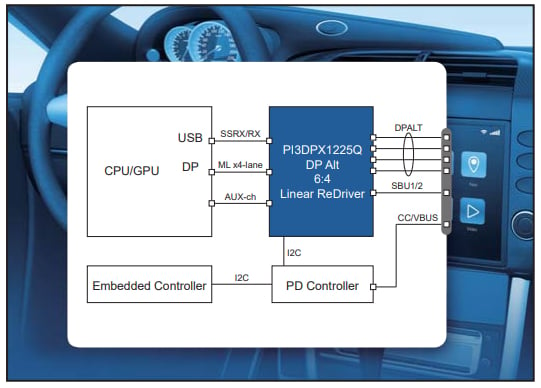With the rise of electric vehicles, autonomous driving, and connected car ecosystems, engineers are pressured to deliver more performant vehicles without sacrificing safety, reliability, and regulatory compliance.
Amid this backdrop, various players in the automotive industry—including Diodes Incorporated, Waymo, and the U.S. Department of Transportation—have announced new chip-level solutions, complete systems, and initiatives to bring the latest automotive developments to U.S. roads.
Diodes Releases Automotive Redriver
Diodes Incorporated recently announced a new, automotive-compliant crossbar multiplexer solution. The PI3DPX1225Q device is described as a highly integrated USB type-C DP-Alt DP 2.1 and USB 3.2 gen-2 linear redriver.
Diodes designed the PI3DPX1225Q for source-side applications, where it can optimize signal performance across various physical mediums by reducing inter-symbol interference jitters. It achieves this through adjustable equalization, output swing, and gain settings controlled via an I2C interface. The I2C interface operates at speeds up to 1 MHz, providing flexibility in tuning the device for specific application requirements.

RSE application diagram. Image used courtesy of Diodes Incorporated
The device supports data rates up to 10 Gbps, making it compliant with VESA DP Alt 2.1 UHBR10 and USB 3.2 gen-2 standards. It also features a non-blocking linear redriver architecture, improving additive jitter performance compared to conventional CMOS-limiting redrivers. The device couples this feature with integrated linear equalization technology to allow the receiver’s decision feedback equalizer (DFE) to operate without interference.
The device also includes built-in control logic for handling type-C plug and unplug events, including orientation detection and flipping. The chip operates from a single 3.3-V power supply and is AEC-Q100 grade-3 qualified.
Waymo Rolls Out New Autonomous Driving System
Waymo recently unveiled its sixth-generation Waymo Driver system to advance autonomous vehicle systems. The system is characterized by an upgraded suite of sensors, notable cost optimizations, and expanded operational capabilities.
The new generation integrates 13 cameras, four LiDAR units, six radar sensors, and an array of external audio receivers, all of which collaborate to provide a comprehensive 360-degree field of view around the vehicle. This sensor fusion enables the Waymo Driver to detect and interpret its environment up to 500 meters away regardless of weather conditions, including extreme heat, rain, fog, and snow.

The Waymo 6th-generation system. Image used courtesy of Waymo
Waymo claims the new generation reduces the number of sensors without sacrificing any safety-critical redundancies. The new generation cut its sensor count with strategic sensor placement and other technological advances, making production more cost-efficient and enhancing performance. For instance, Waymo optimized its LiDAR system for better range and accuracy and calibrated its radar and camera systems to provide overlapping fields of view.
With millions of simulated miles and thousands of real-world miles already logged, Waymo hopes to expedite Driver’s deployment.
Transportation Department Pushes V2X
The U.S. Department of Transportation (DOT) has released a comprehensive plan to deploy vehicle-to-everything (V2X) technology across the nation’s roadways.
V2X technology facilitates wireless communication among vehicles, infrastructure, and other road users and is considered central to the DOT’s strategy for zero roadway fatalities. The plan outlines the technical architecture, performance targets, and deployment goals to achieve secure, interoperable V2X systems.

The V2X deployment plan timeline. Image used courtesy of the U.S. DOT
The plan emphasizes the importance of using the 5.895–5.925 GHz spectrum band for enabling low-latency, high-reliability communication. The DOT’s roadmap also sets specific deployment targets, including installing V2X technology on 20% of the National Highway System and 25% of signalized intersections in the top 75 metro areas by 2028. By 2036, V2X is expected to be fully deployed across the National Highway System, with 85% of intersections in major metro areas enabled.
The plan also highlights the need for secure, interoperable systems, focusing on developing a security credential management system (SCMS) to safeguard communications against cyber threats.
The Next Wave of Automotive Innovation
The developments covered in this article signal a clear trend toward more integrated, intelligent, and connected vehicles. The push for enhanced sensor systems, robust V2X communication, and efficient multiplexing solutions suggest that the path forward will increasingly rely on cohesive hardware and software integration. This, in turn, will demand even closer collaboration between technology developers, automakers, and regulators. How these innovations will shape the next decade of mobility remains to be seen, but the trajectory points to a more autonomous, efficient, and safer driving experience.
